
If you’ve heard about compression socks for women but aren’t sure what all the hype is about, you’ve come to the right place. Compression socks are a type of specially designed hosiery that are worn for health and wellness reasons. You may have also heard them called compression stockings or support hose.
Perhaps you’re thinking that you know what compression socks are because your grandmother used to wear them. But this misconception–that compression hose are for seniors only–means that many of us are bypassing the health benefits of wearing pressure socks.
Compression wear has made leaps and bounds in terms of style and fashion. With so many options, it has become easier to incorporate compression hose and socks into your daily routine. They not only provide your legs with the support needed to fight against swelling, fatigue and varicose veins, but they can look great while doing it.
What Are Compression Socks for Women?

Compression socks can be worn by either men or women and are made from durable materials that apply compression to the legs. They are a non-invasive, therapeutic treatment used to provide extra pressure that supports the veins of the legs. Depending on your age, activity level or mobility, wearing compression socks could be beneficial to your overall health.
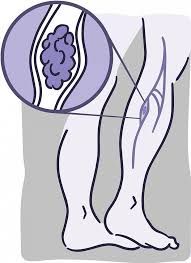
Compression socks can help prevent or relieve the symptoms of mild to serious medical conditions. The conditions that respond best to compression therapy are those related to venous disorders such as varicose veins, deep vein thrombosis (DVT), phlebitis and edema.
Compression socks may also be used by people who travel a lot, as they are often sitting on airplanes or buses for extended periods of time. To help stimulate blood flow in the legs when it is lacking due to inactivity, a mild to moderate pressure rating is needed.
In addition, compression socks are worn by athletes worldwide to aid them in performance as well as recovery from injuries. Nurses and those in professions that require standing for many hours at a time will also benefit from the improved circulation provided by compression socks.
If you have a medical condition that would benefit from compression socks, your doctor may recommend compression therapy to you and give you a prescription for them. Compression wear with a pressure rating of 30mmHg and below can also be purchased over-the-counter at ComproGear or at pharmacies without the need for a prescription.
How Do Women’s Compression Socks Work?

As the blood in your body travels down towards your ankles and feet, it has the help of gravity to get where it needs to. But moving the blood back up to the heart is where it becomes challenging.
Compression stockings for women help fight against gravity. The compressing action of pressure socks promotes the movement of blood and increases blood vessel valve effectiveness. This enables better circulation, pushing the blood from the legs and back up towards the heart.
Without compression stockings, blood in the feet and legs moves at a much slower pace. As a result, blood can pool in the lower extremities. Blood clots can also become more prevalent when circulation is poor. Using compression hosiery to prevent venous stasis, varicose veins, spider veins and feelings of heaviness or soreness in the legs has become common practice.
Compression Sock Pressure Levels
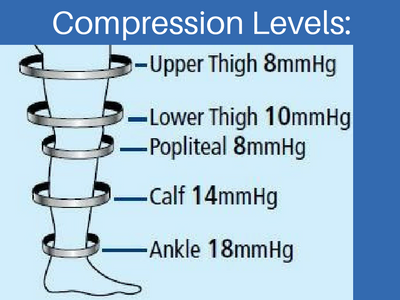
The amount of pressure applied by compression socks will vary based on design. The levels are measured in mmHg (millimeters of mercury). Depending on your personal needs, you will be able to choose from a variety of compression levels, though 20-30mmHg is the most widely used.
It is common for compression hosiery to use graduated compression. The pressure applied by socks with graduated compression is strongest at the ankle. The pressure decreases as the sock moves up to the calf or thigh, making it easier to push blood and fluids back up toward the heart.
You will typically find the following pressure ranges available for purchase:
Mild: 15-20mmHg of Pressure
This is used for mild swelling and is sold without a prescription. Compression socks with this pressure range are often used by travellers or workers who sit for extended periods of time (truck drivers, office workers, etc.).
Medium: 20-30mmHg of Pressure
This is the level most commonly recommended by doctors. It is worn for mild to moderate edema and lymphedema, as well as varicose vein prevention. Your doctor may also ask you to wear this level of pressure if you are at risk of deep vein thrombosis (DVT).
Firm: 30-40mmHg of Pressure
This pressure level is used to treat moderate to severe edema and lymphedema conditions. A doctor’s supervision is required for high levels of compression such as this.
Extra Firm: 40-60mmHg of Pressure
This level must be used only under a doctor’s supervision and is only prescribed for patients with advanced medical conditions.
Why Do You Need Compression Socks?
Adding a pair of compression socks to your daily wardrobe can do wonders for your health. Take a look at the ways they can benefit you:
1. Reduce Swelling:
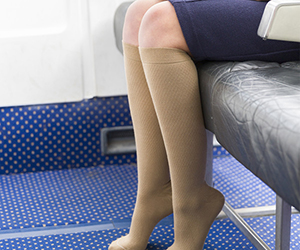
If your body has a tendency to hold fluid, especially in the legs and ankles, women’s compression stockings can help to reduce that swelling. Swollen areas of the leg can become painful and uncomfortable. Compression socks can help control that swelling and increase the circulation of blood to the area to aid in fast pain relief.
2. Increasing Blood Circulation:
When circulation is not optimal, the legs can lose their strength, become sore and are vulnerable to developing varicose veins. Wearing compression socks can improve the effective delivery of blood which can relieve pain and discomfort. However, if you have any medical concerns or diagnoses related to circulation, ComproGear highly recommends checking with your doctor before wearing compression socks.
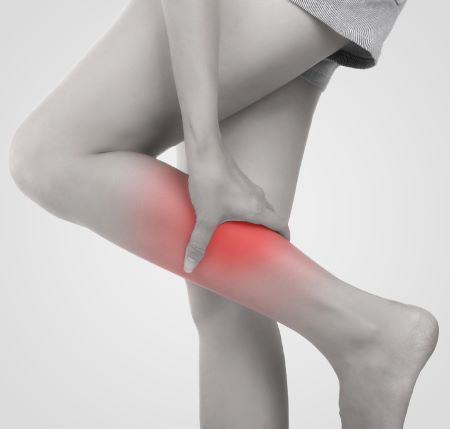
3. Pain Relief:
If you want your legs to have an additional layer of support, compression socks for women may be very useful in minimizing pain caused by poor circulation or varicose veins. When you experience fatigue, spasms or sprains caused by rigorous exercise, compression socks will also help reduce pain and promote faster healing.
4. Boost Athletic Performance:
Many athletes wear compression socks to boost their endurance and receive extra support to the calves and thighs. By promoting healthy circulation, a steady supply of oxygen is delivered to the muscles which can improve performance. In addition, the use of compression socks can minimize the amount of lactic acid that builds up in the muscles, cutting down on post-workout soreness and cramping.
Fitting Guide for Compression Socks
Compression socks come in a variety of lengths and sizes. Thigh-high, knee-high and full-length pantyhose women’s compression stockings are all available on the market. Doctors usually recommend wearing knee-high stockings for those who are experiencing swelling and/or varicose veins below the knee.
For those with swelling or varicose veins above the knee, full-length pantyhose or thigh-high compression stockings may be the best option. For the best results, compression socks should not fit too tightly or too loosely.
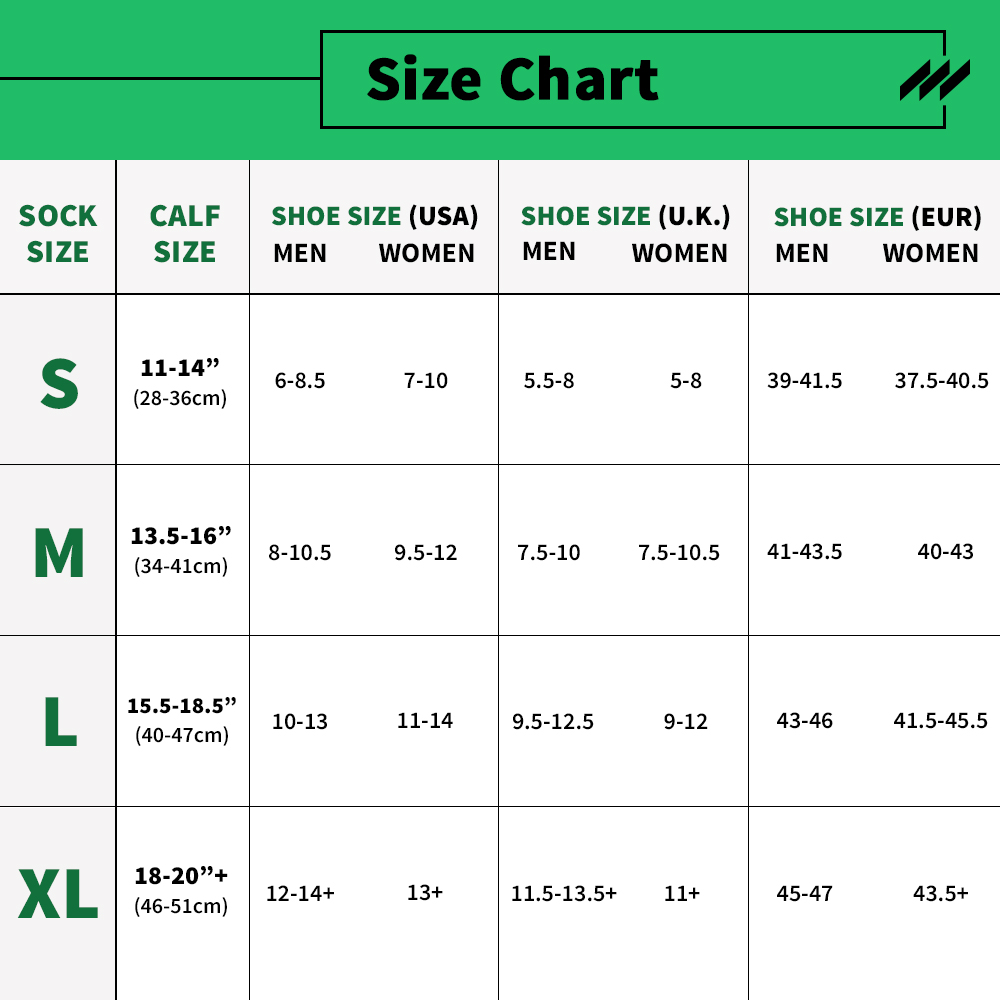
There is no standard sizing measurement when it comes to women’s compression socks. As with many products, different brands follow different size guides. Consult the brand’s sizing pattern to find the perfect size for yourself.
ComproGear uses the size chart pictured on the left. To find your size for knee-high socks, you will need to take a measurement of the widest part of your calf. This is the most important measurement. You can also use your shoe size to help taper-down sizing options.
If you want thigh-high or full-length stockings, you will need to take a measurement from the base of your heel to the mid thigh or inseam. This will help you determine the height of stocking you should aim for.
You will also need to measure around your mid-calf region as well as your mid-thigh circumference. You may want to measure each leg individually because they can differ in size.
Women’s Compression Socks: What You Should Know
Compression socks can help women find relief from discomfort, making it easier to lead a normal life uninterrupted by pain. Here are a few tips to remember when purchasing and wearing your compression socks for women:
- Try on and put on your compression socks first thing in the morning as any swelling in the legs is usually low at this time.
- Fit is vital. A size too large will provide inadequate compression and will prevent the wearer from achieving the desired results. On the other hand, excessive compression can lead to other complications such as hyper-pigmentation, lipodermatosclerosis or stasis dermatitis. To avoid these issues, consult a healthcare professional to assist you with proper fitting or follow ComproGear’s measuring tips.
- Some people find that using talc powder or cornstarch can help their tight compression socks slide onto their legs more smoothly.
- Do not wear compression socks in the shower or bath.
- To keep your socks fresh and free from bacteria, wash the socks with mild soap in cool water after every use and hang them to dry overnight. Make sure they’re completely dry before putting them on again.
- Patients with peripheral arterial disease (PAD) should avoid compression socks. In fact, people with any diagnosed circulatory condition should check with their doctor prior to using compression socks.
Symptoms of Incompatibility
Sometimes compression socks don’t fit quite right and can cause difficulties. If your compression socks do not fit your legs well, you might experience one or more of the following signs and symptoms after you wear them for a few hours:

- Bruising
- Itchiness
- Profuse sweating
- Excessive tightness
- Tingling sensations
- Restricted movement
- Muscle pain and stiffness
- Numbness and lack of sensation
- Lack of proper blood circulation
Inform your healthcare provider if you experience any of the above symptoms or other discomforts. He or she will work with you to adjust your socks properly or make recommendations for an alternate pair of compression socks.
Medical Uses for Women’s Compression Socks
The following are some of the many medical and therapeutic situations in which compressions socks may be recommended by your doctor or pharmacist:

Edema
Swollen ankles, feet and legs, also known as edema, occur when there is a build-up of fluids. If you are standing or sitting in the same position for extended periods, fluid will eventually pool at the feet, causing them to swell. Compression socks help the body work against gravity to promote the flow of fluid and prevent pooling in the extremities.
Deep Vein Thrombosis (DVT)
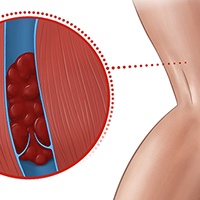
Occurring most often in the thigh or lower leg, DVT is a condition that develops when a blood clot forms due to prolonged standing or sitting. This condition can become dangerous if the clot dislodges and travels to other parts of the body such as the lungs, causing pulmonary embolism or even an aneurysm. Wearing women’s compression socks will help by regulating blood flow and preventing a clot from forming in the first place.
Varicose Veins
Varicose veins occur when blood pools in damaged veins and capillaries, causing them to appear larger and to become visible on the outside of the leg. This condition may occur in other parts of the body too but appears most often in the legs. Compression therapy is usually the recommended action of treatment for those with circulatory problems related to varicose veins.
Pregnancy
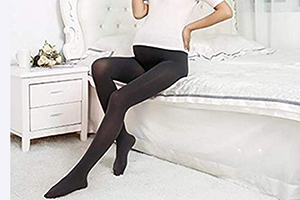
Pregnancy can cause swelling in the feet and puts women at a greater risk of developing varicose veins. Many physicians and specialists recommend wearing women’s compression socks during pregnancy to reduce swelling during standing hours. In addition, pregnant women who are placed on bedrest may be prescribed compression socks in order to promote healthy circulation.
Lymphedema
If a body part develops swelling because of excessive accumulation of lymph fluid, the condition is called lymphedema. This occurs when the drainage of lymph fluid into the blood is hindered, sometimes due to cancer treatments or surgeries. This swelling can often be curbed by using women’s compression socks.
Phlebitis
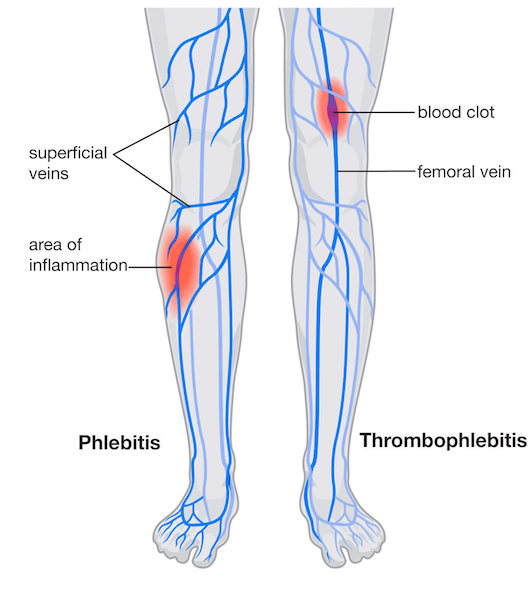
When a leg vein develops clotting and inflammation due to an infection or trauma, the condition is called phlebitis. Patients with varicose veins are more susceptible to phlebitis. The inflammation can happen instantly, causing the thrombus (blood clot) to adhere to the vein wall. Wearing compression socks for women is recommended to prevent such situations.
Non-Medical Uses for Compression Socks for Women
There are many non-medical uses for compression stockings. They can be worn for the prevention of venous disorders or even simply because they feel comfortable and help prevent aches and dizziness. Here are some examples of people who could benefit from wearing compression stockings:
People Who Sit All Day At Work

For people who are sitting all day, the natural circulation process can become less efficient. This often results in fatigue as well as fluid pooling in the legs. Anyone with a desk job or who works a job that requires sitting for multiple hours a day can fight the negative effects of prolonged sitting by wearing compression socks and moving around every 30 minutes.
People Who Stand All Day At Work

Standing for prolonged hours causes discomfort, fatigue and can lead to varicose veins. While movement encourages more blood flow to the heart, prolonged standing can be equally as bad as sitting when it reduces blood flow back to the heart. Trade workers, cashiers, nurses and hospitality staff are all great candidates for compression socks. Give them a try; your legs will feel less fatigued and you’ll have more energy after work.
People Who Exercise Regularly
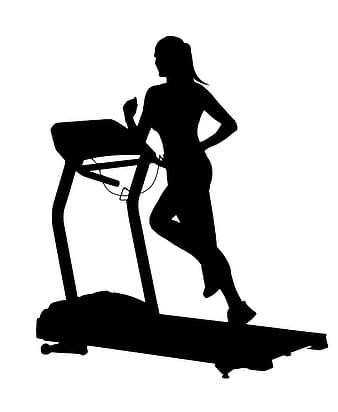
Although studies have not yet confirmed the benefits of compression socks on athletic performance, most athletes swear by them. Runners, basketball players and other athletes suggest that compression socks promote better blood flow during activity, bringing more oxygen to the muscles and preventing tissue damage. Wearing compression socks during a workout has been proven to promote recovery as it reduces lactic acid build-up in the muscles, which then minimizes soreness and cramping.
People Who Travel A Lot

Prolonged sitting on flights or in a car is similar to having a desk job that requires sitting for multiple hours at a time. This lack of movement can lead to blood clots related to DVT. Wearing compression socks will help you avoid blood clots as well as minimize foot and ankle swelling.
Compression stockings are great for both medical and non-medical uses. They are excellent at promoting blood flow from your lower extremities to the heart as well as for reducing swelling.
Whether you’re in need of compression hose for office wear or pressure socks to enhance circulation during recovery after a workout, compression hosiery offers benefits to all. If you think you need them but aren’t sure of what pressure level or compression sock styles would be best for you, check with your doctor–and then consider purchasing your compression socks online so that they can be delivered right to your door!
This page last updated December 2, 2022
